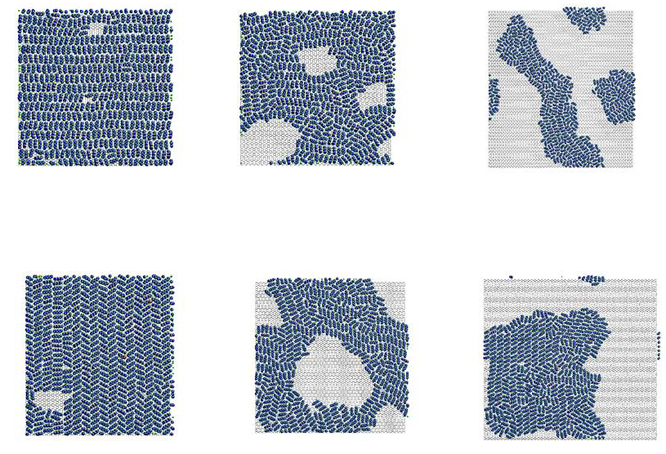

43277-B5
Better Understanding the Behavior of Hexane Deposited onto Graphite Using Improved Computer Simulations
I. General Comments
We met the proposed objectives regarding hexane on graphite (C6/gr) as well as tetracosane on graphite (C24/gr) . Two papers have been published, and several other studies are in progress which will lead to dissemination which credit PRF. The work done has been disseminated in 5 conference presentations with student co – authors.
In addition, the funding over the last three yeas has allowed the PI to continue collaborating with colleagues at UMC and at Penn State, to build collaborations with scientists from Europe and, most importantly, to leverage the experience to benefit local UNI undergraduate students. There will be publications and presentations crediting this source of funding over the next year, and the project will act as a seed for future work and proposals.
II. Hexane on Graphite
III. Tetracosane on Graphite
A paper in press is reported in
IV. Scaling
In studying C24/gr, adjustment of the nonbonded scaling parameter in NAMD simulations is crucial in determining alkane flexibility and hence phase transition temperatures and dynamics. The interplay between torsional potential and the scaling of nonbonded interactions plays a crucial role in all – atom NAMD simulations. Three alkanes (C6, C12, C24), are simulated and the melting temperatures compared to accepted values. Thee scaling parameter is not universal but changes with the molecular length. In fact we are able to plot the optimal scaling factor as a function of backbone length, as shown in Fig. 1. There is also a manuscript in preparation:
L. Firlej, B. Kuchta, M.W. Roth, and C. Wexler, “Mechanism of the melting transition in monolayers of alkanes adsorbed on graphite and the universality of energy scaling”, in preparation

Figure 1. Optimal scaling factor (SF) as a function of the inverse number of the carbons in the alkane backbone.
V. Alkane Percolation
A current percolation
study involves an extensive series of simulations of alkanes at submonolayer
coverages. Melting is directly related to lattice topology, and we concentrate
on where the adsorbate forms a connected (percolating) network. In this regime,
melting temperature is insensitive to density changes. We study four different
species (C5, C6, C12 and C24) with the intent of relating molecular flexibility
to the system’s behavior at percolation. We have completed the study for rigid
molecules (C5; C6, Fig. 2) and have moved on to more flexible species (C12;
C24).

Figure2. Low – temperature snapshots for pentane (top row) and hexane (bottom row) layers on graphite ant various coverages.
We continue to collaborate with Renee Diehl at V. Tetracosane Bilayers The PI and collaborators from Figure3. Final snapshot side view of a C24 bilayer.
Note that the second layer shows considerably more gauche defects and signs of
thermal fluctuations than does the lower layer. VI. Tetracosane Trilayers The PI and the SUMR Scholar also simulated C24 trilayers this summer, with the third layer standing
perpendicular to the substrate and first two parallel layers. In addition, the
upper layer shows interesting concavity on it sides as temperature is increased
up to thermal collapse. The Scholar had some health issues this past summer and
the PI wants to involve him in as much of the science as possible so the
project will be completed and published over the next year. We are currently
running out our simulations for much longer times in order to get better
statistics.
VII. Hydrogen
The
PI conducted some NAMD hydrogen on graphite simulations and the results
are published; the paper is reported in the appropriate electronic
location. VIII. Natural Gas / Crude
Oil The PI and SUMR Scholar began simulating natural gas and
crude oil on graphite – the first such work to our knowledge. The crude oil is
a mixture of alkanes from C6 on up to C30, and
natural gas contains C1 – C5. We see selective adsorbtion
and interesting adsorbed molecule orientation. We are currently running
simulations out for a much longer time in order to get better statistics.


Figure4. Final snapshot of crude oil on graphite. Note the relatively
high abundance of lighter molecules in the gas phase in between the adsorbed
layers.